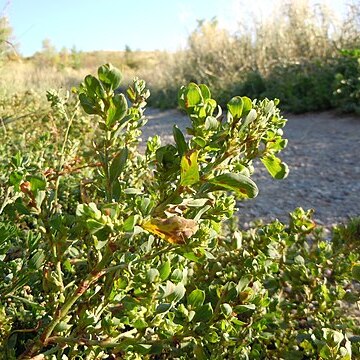Plants light green (often covered with whitish powdery mildew), homophyllous or, sometimes, heterophyllous. Stems erect when young, decumbent or prostrate later, moderately branched especially from base, not wiry, 50-70 cm. Leaves: ocreae 5-12 mm, proximal part cylindric, distal part soon disintegrating into brown fibers; petiole 0.3-1.5 mm; blade light yellowish green, elliptic to obovate, 8-35 × 3-15 mm, margins flat, apex rounded; stem leaves 1-2.1(-3) times longer than branch leaves; distal leaves overtopping flowers. Inflorescences axillary, cymes in axils of most leaves and toward tips of stems and branchs, 1-3(-5)-flowered. Pedicels enclosed in ocreae, 1.3-1.8(-2) mm. Flowers closed; perianth 2.6-4 mm; tube 40-55% of perianth length; tepals incurved, yellow-green with yellow to green, rarely pinkish, margins, sepaloid, ± keeled, narrowly oblong, cucullate; midveins unbranched, moderately to heavily thickened, tepals appearing keeled; stamens 5-8. Achenes enclosed in perianth, yellow-green to tan, ovate, 3-gonous, 2.4-3.5 mm, faces unequal, apex not beaked, edges concave or nearly straight, dull, uniformly tubercled; late-season achenes common, 3-5 mm. 2n = 40, 60.
More
Annual to 5(–7) dm, homophyllous, erect at first, but often becoming prostrate with upturned branches; lvs bluish-green, oval to elliptic with rounded tip, mostly 10–35 × 3–15 mm; ocreae 4–10 mm, becoming brown and lacerate; perianth yellow-green, 2.5–3.7 mm, somewhat bottle-shaped and constricted above the achene, cleft only ca 1/3 its length, the 3 outer lobes narrow, curved, strongly cucullate; achenes 2.4–3.3 mm, yellow-green to tan, uniformly papillose; late-season achenes exsert, to 5 mm, olivaceous, smooth; 2n=40, 60. A weed in waste places, widespread in our region, w. to the Rocky Mts.

